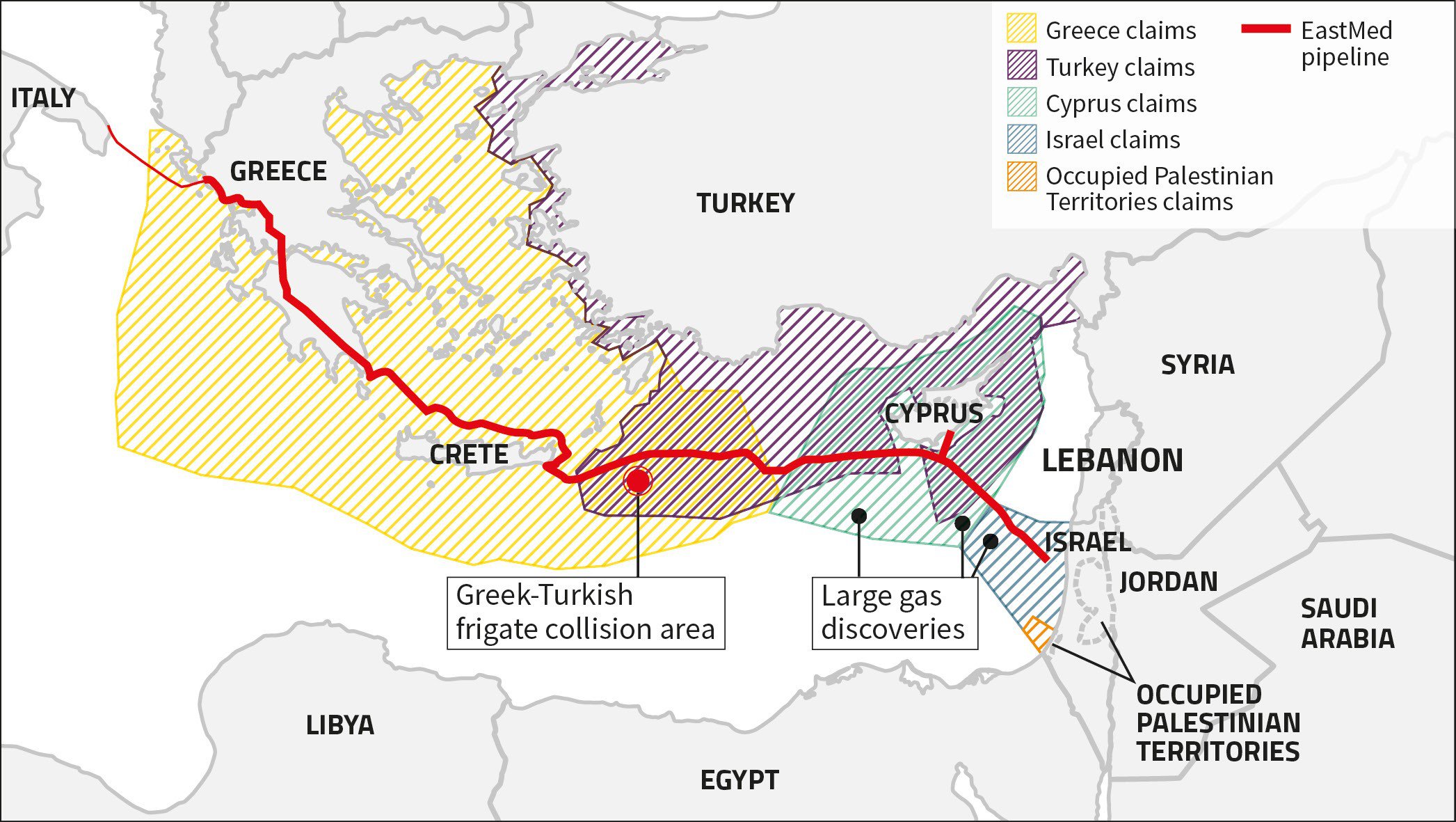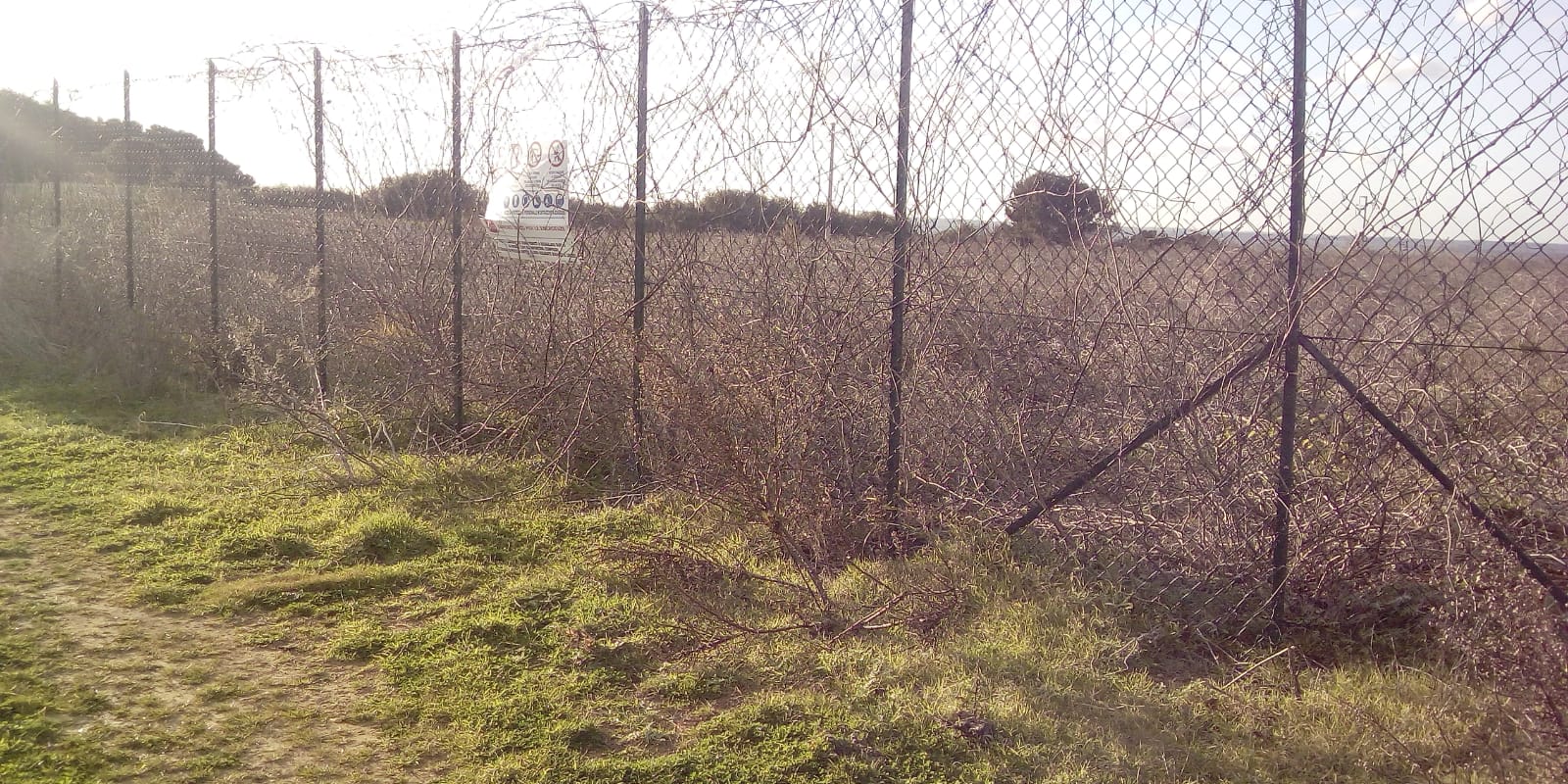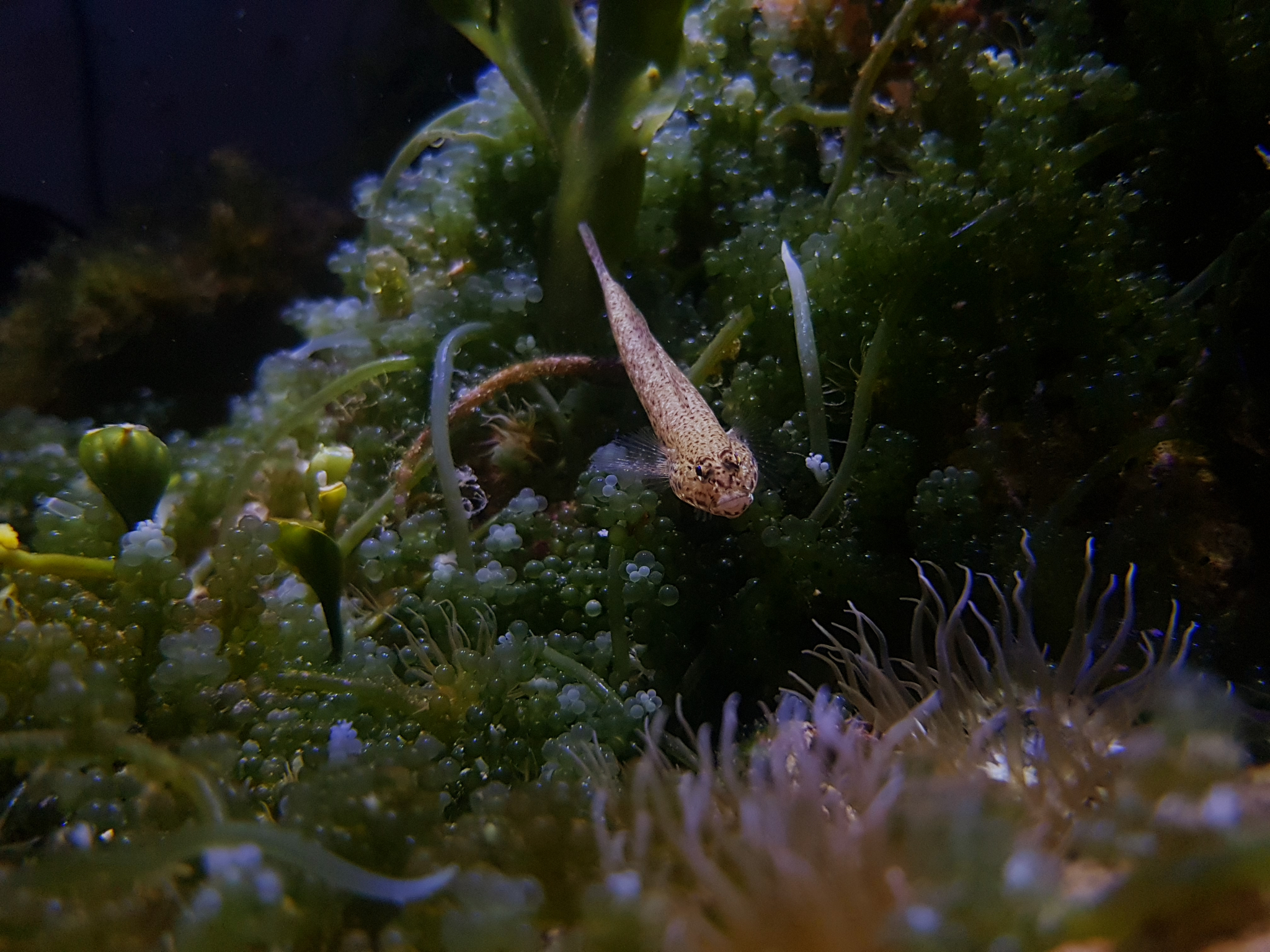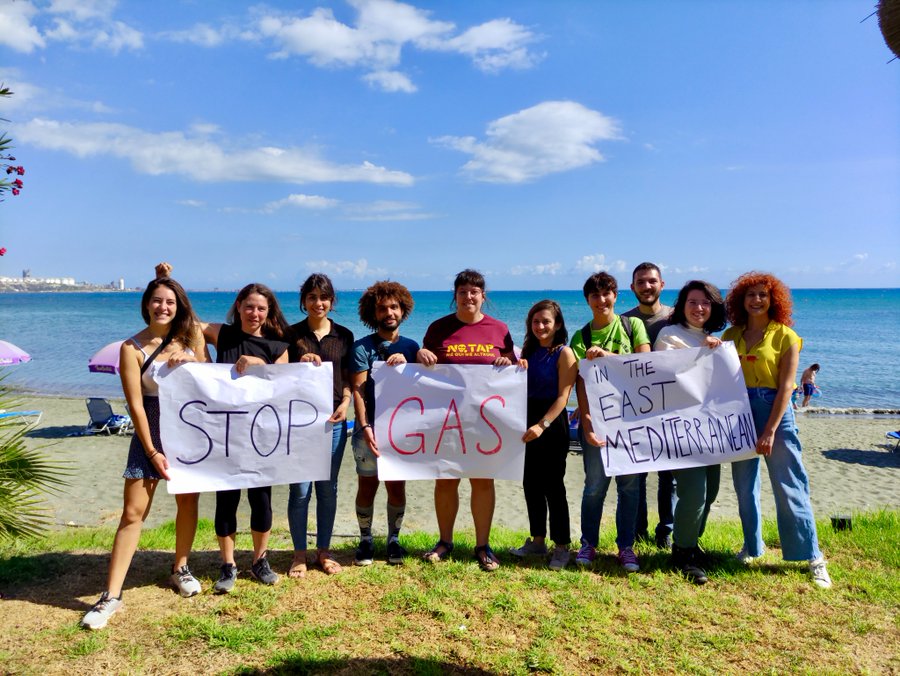EastMed-Poseidon Pipeline
Approximate location. The EastMed-Poseidon pipeline will run from the Eastern Mediterranean via Crete and Greece and on to Italy.
One of Europe’s largest pipeline projects is a geopolitical and environmental troublemaker. The EastMed-Poseidon Pipeline would originate right off the coast of the war zone in Gaza and could cause further tension between Turkey and Greece. In addition, it would bust European climate targets and threaten the underwater life of the Mediterranean Sea. Palestinian and North Cypriot communities in particular would lose out on the benefits that fossil companies and governments would reap.
Note: Reputational risk projects on GOGEL are updated annually. This article was last updated November 11 2024.
Too Long, Too Deep and Too Risky
DEPA and Edison, the proponents of the EastMed-Poseidon project, want to pump gas from the Eastern Mediterranean Sea into the heart of Europe. Their pipeline project consists of two parts. The gas would first flow through the EastMed pipeline from Israeli offshore gas fields via Cypriot and Greek waters to reach the Greek mainland.[1] From Greece, the Poseidon pipeline would again take the gas offshore towards the Italian coast. From there, it would flow on into Europe. Along this route, DEPA and Edison hope to transport up to 20 billion cubic meters of fossil gas every year.15131[2] To develop the project, the two companies have established the Joint Venture IGI Poseidon. Although the war in Gaza has made it highly unlikely that their pipeline project will go ahead, they are holding on to the plan of exporting huge amounts of gas from the region.21441
If EastMed-Poseidon goes online, it would become one of the longest gas pipelines in Europe and one of the deepest subsea pipelines in the world.15151 It would take more than 17 hours at 120 km/h (75mph) to drive the pipeline's total length of 2,110 km (13,117 mi).[5] The 1,350 km (839 mi)-long offshore section of the EastMed pipeline between Israel and Greece would reach as deep as 3,000 meters (9842 ft).[6] With a EUR 5.98 billion price tag, the EastMed pipeline alone could quickly become one of the most expensive pipelines in the European Union (EU).[7] It is not yet clear who would be willing to finance the costly project.1242515133
A Geopolitical Minefield
After the failure of Nord Stream 2, the EU has been running towards the next geopolitical hornet’s nest. While Israel, Cyprus and Greece passionately promote EastMed, their maritime neighbor Turkey opposes the project.[9] The Turkish government does not want competition for the Southern Gas Corridor, which runs from Azerbaijan through Turkey to Europe.[10]
Since the 1970s, Turkey, Greece and Cyprus have been in conflict over their maritime borders.[11][12] In 2019, Turkey and Libya tried to redraw the borders in the Eastern Mediterranean Sea.[13] The Turkish government said that it wanted to protect its rights and waters. Effectively, the two countries created a geopolitical barrier in the middle of the proposed path of the EastMed pipeline.[14] Greece and Cyprus do not recognize the boundaries drawn up by Libya and Turkey.[15] Still, they do not know how the Turkish government would react if they decide to ignore Turkey’s claims and push the project forward.
Oil and gas discoveries in the Eastern Mediterranean have only worsened the conflicts between Turkey and its neighbors.[16] Whenever research vessels or drilling ships enter disputed waters, military warships follow to protect them.[17][18] In August 2020, aggressions peaked when a Turkish research ship searched for oil and gas in disputed waters. When the Greek military tried to block their way, a Greek and a Turkish warship collided.[19] No one knows when the situation might escalate again. NGOs from the respective countries doubt that EastMed could bring peace to this geopolitically tense region, as some politicians claim.[20] The StopEastMed campaign has argued from the beginning that the pipeline and further gas expansion could heat up the conflict in the Eastern Mediterranean even more.[21][22]

“In the Mediterranean, all the coastal states, and some major powers, are saber rattling over fossil fuel reserves under the sea. These dangerous rivalries threaten the safety of all the peoples of our countries […] We say no to new fossil fuel exploration and development of reserves! We say no to conflict between our countries! We say yes to climate justice and to peace!”
Petition to end the fossil fuel race in the Eastern Mediterranean signed by more than 60 organizations from Turkey, Greece and Cyprus.[23]
Levantine Gas for Europe
The gas for the EastMed-Poseidon pipeline would come from the Levantine Basin.15149 This deep marine basin holds an enormous amount of fossil fuels.[24] It lies in the Mediterranean Sea between Cyprus, Lebanon, Israel and Palestine. Since the early 2000s, fossil gas companies have become increasingly eager to explore and drill for new gas in the Levantine Basin.[27] The European energy crisis has given their expansion plans new impetus.[30] But even before the war in the Middle East broke out, they put the financial viability of the EastMed-Poseidon pipeline project into question.15135
The only gas producer in the Levantine Basin that has formally committed to the EastMed-Poseidon pipeline is a company that faces accusations of conducting business within legal grey zones. The gas producer Energean has signed a contract to supply the EastMed-Poseidon pipeline with 2 billion cubic meters of gas every year.[31] In 2010, Energean’s co-founders allegedly took advantage of a dubious banking scheme involving the Cypriot bank Laiki. The international organization Global Witness investigated how the bank loans that Energean’s co-founders and others received propped up the dying business of the Laiki Chairman and helped the young company Energean grow.12421 At the same time, these loans potentially contributed to crashing the Cypriot economy.[32] Energean’s involvement further weakens trust in the EastMed-Poseidon project. Chevron, Eni, Shell and the other gas producers of the Levantine Basin have yet to put their signature under the EastMed-Poseidon project.15137 Nevertheless, they most likely stand to benefit if it ever goes through.[33]15139
A Gas Fortune at the Cost of Local Communities
All along the route of the EastMed Poseidon pipeline, local communities stand to suffer from the project. The Israeli government senses big opportunities from gas production for the EastMed-Poseidon pipeline. Until 2020, Israel was completely dependent on energy imports.[34] Since then, huge offshore discoveries of natural gas have even allowed them to become a gas supplier for Jordan and Egypt.2144221443
Israel aims to generate more profits from a resource that it has historically refused to share with Palestinians in Gaza and the West Bank. Although the Israeli government granted Palestinians access to a 37 km strip (20 mi) off the coast of the occupied Gaza strip, Palestinians have never had much say over the gas resources located there.[36] Since 2000, Israeli authorities and the military have control increasingly restricted access to fishingthe waters and the gas fields.[37] The ongoing bombardment of the Gaza strip by the Israeli military has pushed the Palestinian people’s self-determination over their resources and energy politics into an indefinite future.
Since the start of the war, Gaza has been cut off of fuel and power supplies. While the few remaining functioning hospitals are struggling to access the fuel they need to save lives, oil and gas companies are proceeding with gas expansion off Gaza’s coast.21444 Shortly after Israel started bombing Gaza in the wake of the Hamas attacks on October 7 2023, the Israeli government granted new gas exploration licenses in the Levantine Basin.21445 Palestinian human rights groups challenge the licences awarded to the Italian major Eni SpA, KNOC’s UK subsidiary Dana and Israeli company Ratio Energies for falling within Palestine’s maritime boundaries.21446 Additionally, Chevron and its partners are on the verge of expanding their gas production from the major Leviathan field in the Levantine Basin.2144721448 Much of the gas that would run through the EastMed-Poseidon pipeline would truly come from the Leviathan reserves.21449
In Cyprus, the peace between the Turkish-Cypriot communities in the north and the Greek-Cypriot communities in the south is fragile. If the pipeline reignites military tensions between Cyprus and Turkey, the people of Cyprus will bear the cost of militarization.[39] In Italy, the Poseidon pipeline would run ashore in Otranto, only around 20 km (12 mi) from the Trans Adriatic Pipeline (TAP), the final section of the Southern Gas Corridor.[40] Many people living in the area have received fines and faced immense legal costs for resisting TAP.[41] The Poseidon pipeline would deal them yet another blow.

Intrusion of A Biodiversity Hotspot
Deep below the waves of the Mediterranean Sea lies a mystic underwater world. Submarine canyons, mud volcanoes and seamounts cover the seafloor.[42] Scientists are still exploring what lives under crushing pressures in this moon-like landscape.[43] Despite its small area, the Mediterranean Sea is home to numerous marine animal and plant species.[44] More than 17,000 marine species live in the Mediterranean Sea.[45] 20 to 30 percent of these are unique to the region.[46] Today, climate change troubles the rare ecosystem.[47] Pollution and global warming threaten to wipe out many of the species that live in this biodiversity hotspot.[48] For DEPA and Edison, these endangered dark and unknown waters are nothing more than a construction site for their EastMed pipeline.

Climate Costs
The EastMed-Poseidon pipeline runs counter to the EU’s own climate targets and the global agreement to limit global warming to 1.5°C. The EastMed-Poseidon project would add to Europe’s climate bill, not reduce it - as the Greek company DEPA claims.15143 A 2023 Greenpeace study estimated that total greenhouse gas emissions from the pipeline could amount to as much as 27.7 million tons of CO2eq annually.15145 The report details that the EastMed project alone would make up more than 10% of the carbon budget that remains for the entire EU under its commitment to the Paris 1.5°C limit.15153
Despite the climate costs of EastMed-Poseidon, the EU has repeatedly thrown its weight behind the pipeline.[53] Like the Southern Gas Corridor, EastMed is among the EU’s favorite fossil gas projects. In 2015, EastMed was announced as a European “Project of Common Interest” (PCI).12431 The PCI status qualifies EastMed for fast-tracked permits and EU funds.12429 So far, the EU has handed out more than EUR 36 million to the project.12433 In November 2023 April 2022, the European Parliament Commission voted announced to continue political and financial support for the EastMed project by maintaining the status of common interest.1243521451
Not Dead Yet
In January 2022, the United States withdrew its support for the EastMed pipeline.15155 Despite the ongoing war in Israel, Palestine and Lebanon, the companies have not cancelled their plan to construct the mega pipeline. However, in April 2024, they announced a review of the project’s economic viability and postponed the final investment decision. They are also looking into alternative pipeline projects connecting Cyprus to Israel.21452 Environmental groups won’t stop protesting until all involved companies and governments have truly abandoned the EastMed-Poseidon project and any related projects. More than 100 European organisations have urged the EU to stay away from the pipeline.21453 Their message is clear: There is no space for a problem-pipeline like EastMed-Poseidon in Europe.

Groups working on EastMed-Poseidon: Kazma Birak, PENGON (Palestinian Environmental NGOs Network), ReCommon, Green Course, Gastivists, Avli Collective, Friends of the Earth Cyprus, Palestinian BDS National Committee, Global Witness
Sources: